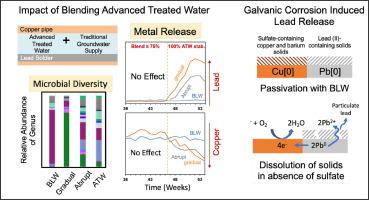当前位置:
X-MOL 学术
›
Water Res.
›
论文详情
Our official English website, www.x-mol.net, welcomes your
feedback! (Note: you will need to create a separate account there.)
Impacts of blending advanced treated water and traditional groundwater supply on lead and copper concentrations and microbial diversity in premise plumbing
Water Research ( IF 11.4 ) Pub Date : 2024-10-30 , DOI: 10.1016/j.watres.2024.122726 Anushka Mishrra, Lin Zhang, Janelle Junior, Fangqiong Ling, Nicole K. Blute, Daniel E. Giammar
Water Research ( IF 11.4 ) Pub Date : 2024-10-30 , DOI: 10.1016/j.watres.2024.122726 Anushka Mishrra, Lin Zhang, Janelle Junior, Fangqiong Ling, Nicole K. Blute, Daniel E. Giammar

|
In response to stresses on water demands, some regions augment conventional drinking water sources with alternative water supplies such as desalinated seawater and reclaimed wastewater. The advanced treatment of wastewater by reverse osmosis, microfiltration, and advanced oxidation processes can produce high quality water for potable uses. However, if not appropriately stabilized, the resulting water can be corrosive to metal-based distribution pipes and plumbing materials. We conducted long-term premise plumbing pipe loop experiments with copper pipes containing lead solder to test the impact of the introduction of advanced treated water on the water quality. Advanced treated water (ATW) originally at low pH (<7) and low alkalinity (<10 mg/L as CaCO3) was stabilized with a calcite contactor before being blended with baseline ground water (BLW). The effects of percentages of ATW on the release of lead and copper and on the changes in the microbial diversity were monitored. Experiments monitored metal release from pipes receiving (1) only BLW, (2) a series of blends of BLW and ATW that gradually increased from 25 % to 100 % ATW, and (3) an abrupt switch from BLW to 100 % ATW. Introducing 100 % ATW dramatically increased lead release and simultaneously decreased copper release. Pipe scale analysis showed that the introduction of ATW had destabilized sulfate-containing pipe scales, which exposed the copper pipe surface to galvanic corrosion. The dissolution of scale material was associated with a significant decrease in sulfate concentration in the 100 % ATW which was in agreement with theoretical solubility calculations. The impact of blending ATW on microbial diversity was studied via 16S rRNA gene amplicon sequencing. The composition of the microbial communities changed significantly after water was in contact with the copper pipes in experiments with both BLW and ATW. The type of water recirculating in the pipes affected the structure of the microbial community. The results from this study can be useful for water utilities that are considering potable reuse as they develop strategies to mitigate any adverse impacts of water quality changes.
中文翻译:

混合高级处理水和传统地下水供应对室内管道中铅和铜浓度以及微生物多样性的影响
为了应对用水需求的压力,一些地区用替代水源(如淡化海水和再生废水)来增加传统饮用水源。通过反渗透、微滤和高级氧化工艺对废水进行深度处理,可以生产出高质量的饮用水。但是,如果稳定性不佳,产生的水可能会对金属基分配管道和管道材料产生腐蚀性。我们用含铅焊料的铜管进行了长期的前提管道回路实验,以测试引入高级处理水对水质的影响。最初处于低 pH 值 (<7) 和低碱度(<10 mg/L 为 CaCO3)的先进处理水 (ATW) 在与基线地下水 (BLW) 混合之前用方解石接触器稳定。监测 ATW 百分比对铅和铜释放以及微生物多样性变化的影响。实验监测了从接受 (1) 仅 BLW 的管道中释放的金属,(2) 一系列 BLW 和 ATW 混合物,这些混合物逐渐从 25 % 增加到 100 % ATW,以及 (3) 从 BLW 突然切换到 100 % ATW。引入 100 % ATW 显著提高了铅的释放量,同时降低了铜的释放量。管垢分析表明,ATW 的引入使含硫酸盐的管垢不稳定,使铜管表面受到电偶腐蚀。水垢材料的溶解与 100 % ATW 中硫酸盐浓度的显着降低有关,这与理论溶解度计算一致。通过 16S rRNA 基因扩增子测序研究混合 ATW 对微生物多样性的影响。 在 BLW 和 ATW 实验中,水与铜管接触后,微生物群落的组成发生了显着变化。管道中再循环的水的类型影响了微生物群落的结构。这项研究的结果对于正在考虑饮用再利用的水务公司非常有用,因为他们正在制定策略来减轻水质变化的任何不利影响。
更新日期:2024-10-30
中文翻译:

混合高级处理水和传统地下水供应对室内管道中铅和铜浓度以及微生物多样性的影响
为了应对用水需求的压力,一些地区用替代水源(如淡化海水和再生废水)来增加传统饮用水源。通过反渗透、微滤和高级氧化工艺对废水进行深度处理,可以生产出高质量的饮用水。但是,如果稳定性不佳,产生的水可能会对金属基分配管道和管道材料产生腐蚀性。我们用含铅焊料的铜管进行了长期的前提管道回路实验,以测试引入高级处理水对水质的影响。最初处于低 pH 值 (<7) 和低碱度(<10 mg/L 为 CaCO3)的先进处理水 (ATW) 在与基线地下水 (BLW) 混合之前用方解石接触器稳定。监测 ATW 百分比对铅和铜释放以及微生物多样性变化的影响。实验监测了从接受 (1) 仅 BLW 的管道中释放的金属,(2) 一系列 BLW 和 ATW 混合物,这些混合物逐渐从 25 % 增加到 100 % ATW,以及 (3) 从 BLW 突然切换到 100 % ATW。引入 100 % ATW 显著提高了铅的释放量,同时降低了铜的释放量。管垢分析表明,ATW 的引入使含硫酸盐的管垢不稳定,使铜管表面受到电偶腐蚀。水垢材料的溶解与 100 % ATW 中硫酸盐浓度的显着降低有关,这与理论溶解度计算一致。通过 16S rRNA 基因扩增子测序研究混合 ATW 对微生物多样性的影响。 在 BLW 和 ATW 实验中,水与铜管接触后,微生物群落的组成发生了显着变化。管道中再循环的水的类型影响了微生物群落的结构。这项研究的结果对于正在考虑饮用再利用的水务公司非常有用,因为他们正在制定策略来减轻水质变化的任何不利影响。


















































 京公网安备 11010802027423号
京公网安备 11010802027423号